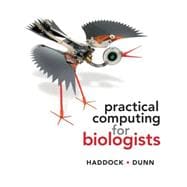Increasingly, scientists find themselves facing exponentially larger data sets and analyses without suitable tools to deal with them. Many biologists end up using spreadsheet programs for most of their data-processing tasks and spend hours clicking around or copying and pasting, and then repeating the process for other data files.
Practical Computing for Biologists shows you how to use many freely available computing tools to work more powerfully and effectively. The book was born out of the authors' own experience in developing tools for their research and helping other biologists with their computational problems. Although many of the techniques are relevant to molecular bioinformatics, the motivation for the book is much broader, focusing on topics and techniques that are applicable to a range of scientific endeavors. Twenty-two chapters organized into six parts address these topics (and more; see Contents):
*Searching with regular expressions
*The Unix command line
*Python programming and debugging
*Creating and editing graphics
*Databases
*Performing analyses on remote servers
*Working with electronics
While most of the concepts and examples apply to any operating system, the main narrative focuses on Mac OS X. Where there are differences for Windows and Linux users, parallel instructions are provided in the margin and in an appendix. The book is designed to be used as a self-guided resource for researchers, a companion book in a course, or as a primary textbook. Practical Computing for Biologists will free you from the most frustrating and time-consuming aspects of data processing so you can focus on the pleasures of scientific inquiry.
RESOURCES
For Students
The Companion Website includes downloads, community forums, tips and examples, and textbook errata and updates.
For Instructors
The Instructor's Resource Library features all of the textbook's figures and tables, provided in ready-to-use PowerPoint presentations.








